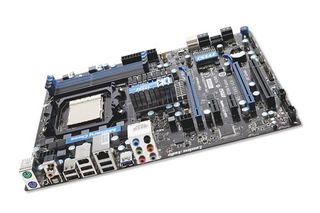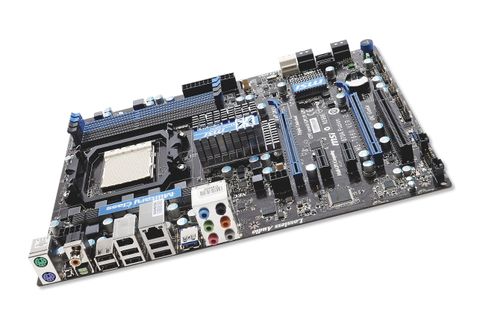Why you can trust TechRadar

The last time a motherboard appeared with Lucid's Hydra chip, it was aimed at the enthusiast and carried a price tag to match.
Now MSI is targeting the 870A Fuzion at a wider audience by pitching it at the mainstream end of the market, and by using a mainstream chipset, the AMD 870A, they've managed to keep costs down. It means they can fit the Lucid Hydra 200 chip and still pitch the board at under £200.
Leaving the Hydra chip aside for a moment, this is a nice board. MSI has overcome the limitations of the chipset by adding a second PCIe x16 graphics slot, so the board can support Crossfire regardless of the Hydra technology.
Using discrete chips for the SATA 6Gbps (Marvell) and USB 3.0 (NEC) has brought the board bang up to date. This means you may not get as many ports as you might via a chipset supporting these natively, but two of each is still better than none.
If you like tinkering about and adjusting all sorts of speed and voltage settings, then there'll be plenty to keep you occupied with the 870A Fuzion. It comes with MSI's Auto OC Genie, which auto-detects the best overclocking configuration for the board in the BIOS.
There's also Unlock CPU Core, which, as the name suggests, helps to unlock hidden cores on your CPU. If this automatic stuff isn't for you, you can get your hands dirty in the BIOS, changing settings. If you really muck this up then there's M-Flash, which enables you to re-flash the BIOS via a USB drive.
The cut-down nature of the 870A chipset can be clearly seen in the Cinebench and X264 benchmarks when it's compared against the more capable 890FX.
In the multi-CPU render test in Cinebench R10, the 870A Fuzion completes the test in 54.14 seconds, nearly eight seconds slower than the 890FX. It's the same picture with the X264 benchmark, with the 870A lagging behind the more advanced 890FX.
The gaming performance results show what a good job MSI has done with engineering in the second PCIe slot. There isn't much of a difference in frame rates in Far Cry 2 between the 870A Fuzion and the 890FX. In Crossfire mode, the 890FX's native support achieved 94.42fps, while the 870A managed 89.59.
When it comes to the Lucid Hybrid chip, things get more complicated, because it seems very much game dependent.
The driver support appears to lean more towards ATI/AMD than Nvidia. When two ATI cards are installed together in a pseudo-Crossfire mode, the average frame rate score of 81.52fps in Far Cry 2 isn't that far away from the two standard setups of the 870A and the 890FX.
When it comes to Nvidia, it's a rather different picture. We got frame rates that, quite frankly, didn't make much sense – in the pseudo-SLI mode, the two cards seemed to show a marked decrease in frame rate than a single card.
Trying to sort out the Fermi performance of the Hydra chip is one of Lucid's top priorities, with frequent driver updates released to try to improve matters.
But on to the rather more important point, and the reason for Hydra's existence: can you put two cards with differing core architectures in the same motherboard and run them together?
Well, we have to say a qualified yes. There are still driver worries, because the performance with the mix of AMD and Nvidia cards falls somewhere between a single card and dual same architecture setups.
We liked
MSI's 870A is a well laid-out board that, despite the price tag, comes with many of the overclocking features found on more expensive boards in the range.
Even without the Lucid technology, it's a half-decent motherboard, but with it, it offers the potential of mixing AMD and Nvidia graphics card technologies on the same motherboard.
We disliked
Lucid's Hydra technology, although easy to install and run, isn't the finished article as yet, and in some cases hampers the graphics performance. There are also a couple of strange port positions on the motherboard.
Verdict
We're pleased MSI has made the effort to try to pitch the idea of multi-GPU, multi-architecture cards at an audience where it possibly it makes more sense, but Lucid's technology still seems very much like a work in progress.
To its credit, Lucid is releasing driver updates on a regular basis as problems are ironed out, and it does at least offer SLI support for an AMD platform.
Follow TechRadar Reviews on Twitter: http://twitter.com/techradarreview

